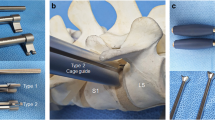Abstract
Background
Endoscopic transforaminal lumbar interbody fusion (TLIF) has the disadvantage of the small cage size and by consequence risk for cage subsidence. We succeeded to insert a large oblique lumbar interbody fusion (OLIF) cage during biportal endoscopic TLIF.
Methods
Unilateral total facetectomy was performed to expose the exiting and traversing nerve roots. The distance between the exiting and traversing nerve roots was measured before OLIF cage insertion. We inserted an OLIF cage instead of a TLIF cage.
Conclusion
We successfully performed modified far lateral biportal endoscopic TLIF using large OLIF cages. Modified far lateral biportal endoscopic TLIF is usually suitable for the L4-5 and L5-S1 levels.







Similar content being viewed by others
References
Heo DH, Park CK (2019) Clinical results of percutaneous biportal endoscopic lumbar interbody fusion with application of enhanced recovery after surgery. Neurosurg Focus 46:E18–E18
Heo DH, Son SK, Eum JH, Park CK (2017) Fully endoscopic lumbar interbody fusion using a percutaneous unilateral biportal endoscopic technique: technical note and preliminary clinical results. Neurosurg Focus 43:E8. https://doi.org/10.3171/2017.5.Focus17146
Heo DH, Sharma S, Park CK (2019) Endoscopic treatment of extraforaminal entrapment of L5 nerve root (far-out syndrome) by unilateral biportal endoscopic approach: Technical Report and Preliminary Clinical Results. Neurospine 16:130–137
Heo DH, Hong YH, Lee DC, Chung HJ, Park CK (2020) Technique of biportal endoscopic transforaminal lumbar interbody fusion. Neurospine 17:S129–S137
Heo DH, Lee DC, Kim HS, Park CK, Chung H (2021) Clinical results and complications of endoscopic lumbar interbody fusion for lumbar degenerative disease: a meta-analysis. World Neurosurg 145:396–404. https://doi.org/10.1016/j.wneu.2020.10.033
Kang MS, Chung HJ, Jung HJ, Park HJ (2021) How I do it? Extraforaminal lumbar interbody fusion assisted with biportal endoscopic technique. Acta Neurochir 163:295–299. https://doi.org/10.1007/s00701-020-04435-1
Quillo Olvera J, Quillo Reséndiz J, Quillo Olvera D, Barrera Arreola M, Kim J (2020) Ten-step biportal endoscopic transforaminal lumbar interbody fusion under computed tomography-based intraoperative navigation: Technical Report and Preliminary Outcomes in Mexico. Oper Neurosurg 19:608–618
Author information
Authors and Affiliations
Corresponding author
Ethics declarations
Conflict of interest
The authors declare no competing interests.
Additional information
Key points
1. Modified far lateral biportal endoscopic TLIF may be an alternative treatment method for lumbar degenerative disease.
2. The indications for modified far lateral TLIF were similar to minimally invasive TLIF or endoscopic TLIF.
3. Central decompressive procedures and total facetectomy may make enough space for the insertion of an OLIF or DLIF cage.
4. Modified far lateral biportal endoscopic TLIF may have limitations for upper lumbar lesions (from L1-2 to L3-4) due to the anatomical characteristics of these levels, including a relatively short distance between the traversing and exiting nerve roots.
5. Preoperative measurement of the distance between the traversing and exiting nerve roots using axial MRI views was important for determining the feasibility of far lateral biportal endoscopic TLIF.
6. If there was not enough space between the traversing and exiting nerve roots, we inserted the usual TLIF cage.
7. Endoscopic endplate preparation may be an advantage of endoscopic TLIF. The cartilaginous endplate can be completely removed without the osseous endplate under a magnified endoscopic view.
Publisher’s note
Springer Nature remains neutral with regard to jurisdictional claims in published maps and institutional affiliations.
This article is part of the Topical Collection on Spine degenerative
Supplementary Information
Rights and permissions
About this article
Cite this article
Heo, D.H., Eum, J.H., Jo, J.Y. et al. Modified far lateral endoscopic transforaminal lumbar interbody fusion using a biportal endoscopic approach: technical report and preliminary results. Acta Neurochir 163, 1205–1209 (2021). https://doi.org/10.1007/s00701-021-04758-7
Received:
Accepted:
Published:
Issue Date:
DOI: https://doi.org/10.1007/s00701-021-04758-7




